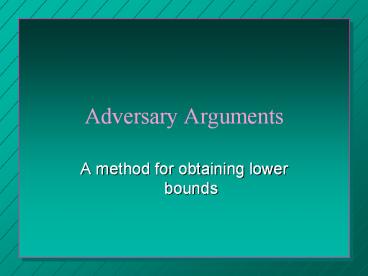Adversary Arguments - PowerPoint PPT Presentation
Title:
Adversary Arguments
Description:
A Second Algorithm Which Intercepts Access to Data Structures ... Compare elements pairwise, put losers in one pile, winners in another pile ... – PowerPoint PPT presentation
Number of Views:197
Avg rating:3.0/5.0
Title: Adversary Arguments
1
Adversary Arguments
- A method for obtaining lower bounds
2
What is an Adversary?
- A Second Algorithm Which Intercepts Access to
Data Structures - Constructs the input data only as needed
- Attempts to make original algorithm work as hard
as possible - Analyze Adversary to obtain lower bound
3
Important Restriction
- Although data is created dynamically, it must
return consistent results. - If it replies that x1ltx2, it can never say
later that x2ltx1.
4
Max and Min
- Keep values and status codes for all keys
- Codes N-never used W-won once but never
lost L-lost once but never won WL-won and
lost at least once - Key values will be arranged to make answers to
come out right
5
When comparing x and y
- Status Response NewStat Info
- N,N xgty W,L 2
- W,N xgty W,L 1
- WL,N xgty WL,L 1
- L,N xlty L,W 1
- W,W xgty W,WL 1
- L,L xgty WL,L 1
- W,L WL,L W,WL xgty N/C 0
- L,W L,WL WL,W xlty N/C 0
- WL,WL Consistent N/C 0
6
Accumulating Information
- 2n-2 bits of information are required to solve
the problem - All keys except one must lose, all keys except
one must win - Comparing N,N pairs gives n/2 comparisons and n
bits of info - n-2 additional bits are required
- one comparison each is needed
7
Results
- 3n/2-2 comparisons are needed(This is a lower
bound.) - Upper bound is given by the following
- Compare elements pairwise, put losers in one
pile, winners in another pile - Find max of winners, min of losers
- This gives 3n/2-2 comparisons
- The algorithm is optimal
8
Largest and Second Largest
- Second Largest must have lost to largest
- Second Largest is Max of those compared to
largest - Tournament method gives n-1lg n comparisons for
finding largest and second largest
9
Second Largest Adversary
- All keys are assigned weights wi
- Weights are all initialized to 1
- Adversary replies are based on weights
10
When x is compared to y
- Weights Reply Changes
- wxgtwy xgty wxwxwy wy0
- wxwygt0 xgty wxwxwy wy0
- wygtwx ygtx wywywx wx0
- wxwy0 Consistent None
11
Accumulation of Weight
- Solution of the problem requires all weight to be
accumulated with one key - All other keys must have weight zero
- Since weight accumulates to highest weight,
weight can at most double with each comparison - lg n comparisons are required to accumulate all
weight
12
Results
- The largest key must be compared with lg n other
keys - Finding the second largest requires at least lg n
comparisons after finding the largest - This is a lower bound
- The tournament algorithm is optimal































